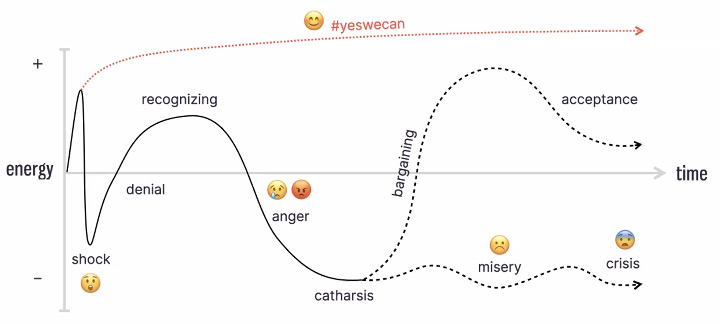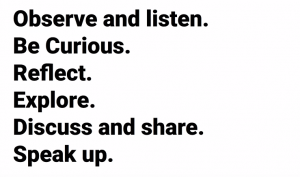Quickly accepting the losses of our “old” normal will help move us into the next phase.
“Never let a serious crisis go to waste,” said the former Obama adviser Rham Emanuel. He recently reprised that quote which he originally used during the 2008 financial crisis. Speaking on ABC’s This Week, Emanuel pointed out, “It’s an opportunity to do the things you once thought were impossible. This has to be the last pandemic that creates an economic depression. We’re going to have more pandemics, but this has to be the last economic depression.” This assessment is a rallying call for design thinkers and creative problem-solvers to use their superpowers and help move our new normal forward in positive, never-thought-of ways. But first, take a breath and let yourself grieve.

Management Coach Maria Giudice describes the process of experiencing change as similar to how we manage the process of grief.
1. 5 Stages of Pandemic Grief

- Denial – shock, confusion, and sadness. (He died? I loved his work.)
- Anger – frustration, and anxiety. (We knew about this WHEN?)
- Bargaining – be open to a positive future. (I get it. Staying at home is a must.)
- Depression – it’s ok to be numb. (It’s Tuesday. No Wednesday. Wait! MONDAY?)
- Acceptance – new plan for the new normal. (I’ve learned that I can ZOOM if it makes sense.)
It’s important to acknowledge the different stages of grief you may be feeling. If we can identify and name our feelings, perhaps we can move it forward.
2. Past Crisis Innovations

Past pandemic outbreaks permanently altered society, and often for the best by leading to better practices and habits. Crisis sparks action and response. Many infrastructure improvements and healthy behaviors we consider normal today are the results of past health campaigns that responded to devastating outbreaks.
- The 1400s: The Bubonic Plague that claimed 200 million lives initiated the practice of quarantine.
- The 1600s: The Great Plague of London killed 20% of the city’s population but led to Shakespeare and Newton’s greatest work while in quarantine and isolation.
- The 1700s: Smallpox may have killed more than a billion people. Vaccines were invented.
- The 1800s: Cholera, which was transmitted through contaminated water, raged. Sewage treatments and access to clean drinking water became a right.
- The 1900s: The Spanish Flu killed over 50 million, more than twice the causalities of WWI. The flu vaccine was created from that worldwide crisis.
- The 2000s: The 9/11 Attacks created tighter airport security (TSA), improved body scanning technology and video surveillance while leading to the increased data mining of terrorist cells.
3. The Steps of Innovation in Times of Crisis

In response to the coronavirus pandemic, innovators are jumping in to help. Carmakers are quickly creating and delivering ventilators to hospitals. Beer makers are now making hand sanitizer. Engineers are using 3-D printers to develop face masks. What these innovations have in common is that they solve problems, which is always at the heart of innovation. And they’ll also be driven by the intensely human desire to help, to connect with other people, and be part of the solution when things get challenging. The hallmarks of creative thinking?
- Prioritizing problem-solving
- Uniting on a shared purpose
- Seeing the system differently and improving
- Being open to change
- Warp drive the pace of ideation
4. Be a Changemaker

Bill Drayton, the founder of Ashoka, says that Ashoka defines a changemaker as “one who desires change in the world, and by gathering knowledge and resources, makes that change happen.” According to Drayton, “changemakers are tenacious about the greater good.” Let’s embrace this sentiment and strive to become a changemaker. They are people:
- People who can see the patterns around them
- Identify the problems in any situation
- Figure out ways to solve the problem
- Organize fluid teams and lead collective action
- Continually adapt as situations change
 After attending an inspiring Kludge online event, I realized we need to take a breath and then rapidly move through the stages of crisis grief to get to the acceptance phase. Only then, can we create a better “Future Normal” together. We’ve got this, creative thinkers.
After attending an inspiring Kludge online event, I realized we need to take a breath and then rapidly move through the stages of crisis grief to get to the acceptance phase. Only then, can we create a better “Future Normal” together. We’ve got this, creative thinkers.
VIEW RELATED CNN ARTICLE: How the ‘hinge event’ of Covid will change everything